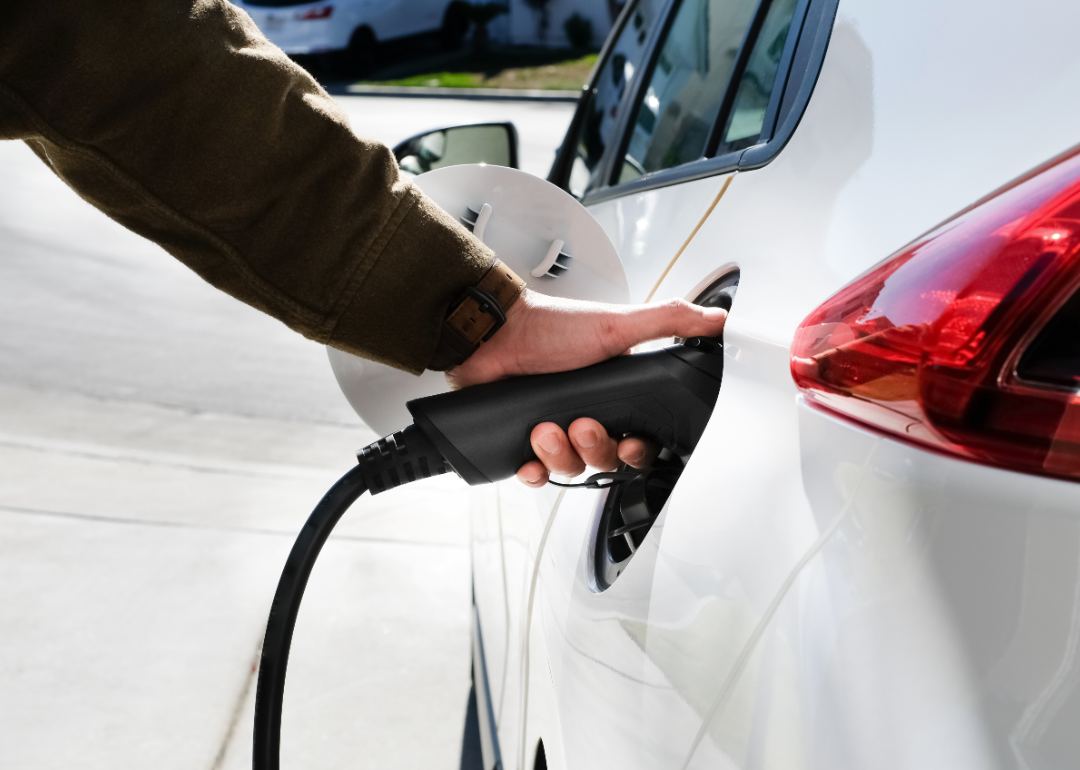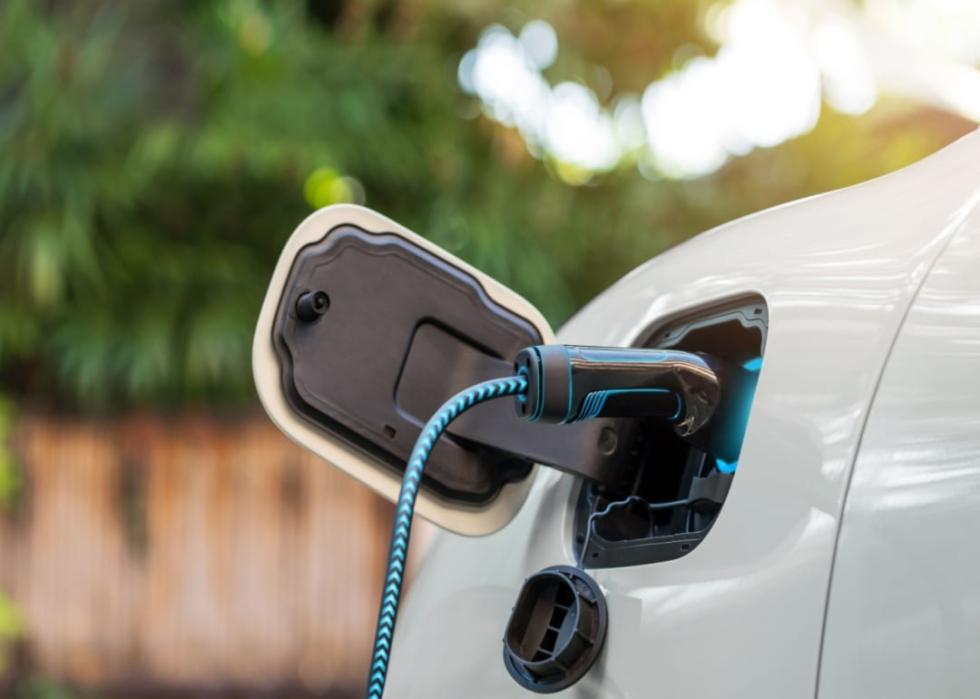
This story originally appeared on Truck Parking Club and was produced and distributed in partnership with Stacker Studio.
How California is committing to electric vehicles
States across the country are paving the way for electric vehicles. This green topic is also harshly divided along red and blue lines—which is to say, it's heavily politicized. In North Carolina and Virginia, for instance, Republican leaders have rolled back or stunted EV initiatives adopted by Democrats.
Former President Donald Trump, the Republican nominee in the 2024 presidential election, has criticized EVs and federal EV policies under President Joe Biden. Trump later backtracked and said he's "for electric cars" for a segment of the population after receiving an endorsement from Tesla CEO Elon Musk. But if elected, Trump still intends to undo Biden-era EV incentives.
To cover current EV incentives and get a sense of the impact that rollback could have, Truck Parking Club compiled information from the Department of Energy to illustrate EV regulations and support in California as part of a broader national analysis.
This analysis only includes public incentives and policies and does not include efforts by private entities or utility providers. It lists major incentives and laws listed on the DOE website as of Oct. 1, which in many cases incentivize other alternative fuels like biodiesel and ethanol in addition to EVs. This list is intended to be comprehensive but not necessarily all-encompassing.

California EV policies
These are the incentives, goals, policies, and privileges offered for EVs and other alternative-fuel vehicles in California.
Government goals, policies, and requirements:
- By 2030, aims to have 5 million zero-emission vehicles on the road
- By 2025, aims to have 200 hydrogen fueling stations and 250,000 EV chargers
- By 2035, all sales of new light-duty passenger vehicles must be zero-emission vehicles
- By 2045, all sales of new medium- and heavy-duty vehicles must be zero-emission vehicles
- By 2035, airport shuttle fleets must adopt 100% zero-emission vehicles
- Starting in 2035, school districts may only purchase or lease zero-emission buses
- By 2040, public transit agencies must adopt 100% zero-emission bus fleets
- Nearly all privately owned heavy-duty diesel vehicles must be retrofitted or replaced to meet updated emissions standards
- Requires transportation network companies to predominantly use zero-emission vehicles and to develop emission reduction plans
- Requires new construction to equip parking spaces with prewiring for EV charging stations, including residential, commercial, and public buildings
- Requires cities and counties to create expedited and streamlined permitting processes for EV charging stations
Monetary incentives:
- Grants to purchase or lease new and preowned EVs, plug-in hybrids, and fuel cell EVs (for income-qualifying residents)
- Grants and vouchers to purchase zero-emission buses
- Grants to replace heavy-duty vehicles with lower-emission alternatives
- Grants to install fueling infrastructure for medium- and heavy-duty zero-emission vehicles
- Grants to install EV chargers (businesses, nonprofits, local governments, and tribal governments)
- Vouchers to purchase electric, hybrid, or natural gas trucks and buses
- Vouchers for larger transit projects in low-income, disadvantaged communities, and tribal areas
- Rebates to replace batteries, fuel cells, or other related vehicle components in eligible used zero- and near-zero-emission vehicles
- Financial incentives to develop and deploy alternative and renewable fuels and advanced transportation technologies
- Locally administered grants and rebates for EV purchases, EV charging stations, and other projects (available in Bay Area, Antelope Valley, El Dorado County, South Coast, and San Joaquin Valley)
- Sales and use tax exclusion for manufacturers of advanced transportation products, components, or systems that reduce pollution and energy use, through 2025
- Property owner loan program for energy improvements, including EV charging stations
Privileges, protections, and exemptions:
- Exempts natural gas, hydrogen, electric, and plug-in hybrid electric vehicles from HOV lane occupancy restrictions, through specified dates
- Only actively charging EVs may park or stop in EV charging spaces
- Renters at residential and commercial properties and residents at multifamily properties must be allowed to install EV charging stations in their designated parking spaces
External collaborations:
- Multi-State Zero-Emission Vehicle Task Force
Other:
- Provides funding and guidance for property owners to develop their own EV charging station incentive programs

Efforts across the nation
In the U.S., the transportation sector is the single leading source of pollution, contributing about 28% of greenhouse gas emissions in 2022. Three-quarters of Americans drive a car to work, most of them alone, and trucks transfer over 60% of freight. As a result, passenger vehicles and freight trucks offer a major opportunity to reduce pollution within the transportation sector.
Efforts to curb vehicular emissions vary widely from state to state. California has led the charge to reduce vehicular greenhouse gas emissions, adopting legislation in 2022 that will require all new vehicles sold in the state to be electric or plug-in hybrids by 2035. Medium- and heavy-duty vehicles like box trucks and semitrucks will follow suit in 2045. Since California's precedent-setting decision, 16 other states have adopted similar mandates with varying timelines and EV sales quotas.
Many states have adopted monetary incentives to promote EV adoption as well. Over half of states provide such incentives to install EV chargers and adopt electric or other alternative fuel buses. Meanwhile, 18 states and Washington D.C. provide monetary incentives for individual residents to purchase EVs. These efforts and others are funded in part by Volkswagen settlement funds, through which the company has paid $2 billion into EV charging infrastructure and $2.9 billion into a state mitigation trust fund in damages for cheating federal emissions tests on nearly 600,000 diesel vehicles.
On a national level, the Infrastructure Investment and Jobs Act is set to invest $7.5 billion in a network of EV charging stations, aiming to add 500,000 chargers across the country. The law includes formulaic state-by-state EV infrastructure funding each year between 2022 and 2026, estimated to total $4.2 billion in all.
Additionally, the 2022 Inflation Reduction Act provides Americans with a $7,500 tax credit for buying new EVs and $4,000 for used EVs, plus credits for commercial clean vehicles, EV charging station properties, continued development and manufacturing of clean energy and transportation technologies, and more.
Many of these efforts may face the chopping block if Trump wins this year's presidential election. The Republican nominee has said he will not allow states to ban gas-powered cars or trucks and may end the national EV tax credit. Meanwhile, Democratic nominee and current Vice President Kamala Harris has supported EV expansion efforts from within the current administration, even casting the tie-breaking vote on the pro-EV Inflation Reduction Act.
The outcome of the election is likely to have major implications for EV adoption and automobile regulation. Read the national analysis to get a deeper sense of efforts across the country—and which states may be most affected by federal policy changes.
This story features data reporting and writing by Paxtyn Merten and is part of a series utilizing data automation across 48 states and Washington D.C.



